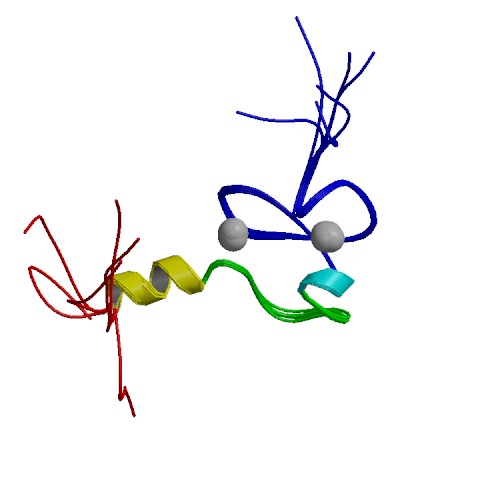ING3
| Inhibitor of growth family, member 3 | |||||||||||||
|---|---|---|---|---|---|---|---|---|---|---|---|---|---|
 PDB rendering based on 1x4i. | |||||||||||||
| |||||||||||||
| Identifiers | |||||||||||||
| Symbols | ING3 ; ING2; Eaf4; FLJ20089; p47ING3 | ||||||||||||
| External IDs | Template:OMIM5 Template:MGI HomoloGene: 6804 | ||||||||||||
| |||||||||||||
| RNA expression pattern | |||||||||||||
 | |||||||||||||
| More reference expression data | |||||||||||||
| Orthologs | |||||||||||||
| Template:GNF Ortholog box | |||||||||||||
| Species | Human | Mouse | |||||||||||
| Entrez | n/a | n/a | |||||||||||
| Ensembl | n/a | n/a | |||||||||||
| UniProt | n/a | n/a | |||||||||||
| RefSeq (mRNA) | n/a | n/a | |||||||||||
| RefSeq (protein) | n/a | n/a | |||||||||||
| Location (UCSC) | n/a | n/a | |||||||||||
| PubMed search | n/a | n/a | |||||||||||
Inhibitor of growth family, member 3, also known as ING3, is a human gene.[1]
The protein encoded by this gene is similar to ING1, a tumor suppressor protein that can interact with TP53, inhibit cell growth, and induce apoptosis. This protein contains a PHD-finger, which is a common motif in proteins involved in chromatin remodeling. This gene can activate p53 trans-activated promoters, including promoters of p21/waf1 and bax. Overexpression of this gene has been shown to inhibit cell growth and induce apoptosis. Allelic loss and reduced expression of this gene were detected in head and neck cancers. Two alternatively spliced transcript variants encoding different isoforms have been observed.[1]
References
Further reading
- Doyon Y, Côté J (2004). "The highly conserved and multifunctional NuA4 HAT complex". Curr. Opin. Genet. Dev. 14 (2): 147–54. doi:10.1016/j.gde.2004.02.009. PMID 15196461.
- Bonaldo MF, Lennon G, Soares MB (1997). "Normalization and subtraction: two approaches to facilitate gene discovery". Genome Res. 6 (9): 791–806. PMID 8889548.
- "Toward a complete human genome sequence". Genome Res. 8 (11): 1097–108. 1999. PMID 9847074.
- Gunduz M, Ouchida M, Fukushima K; et al. (2002). "Allelic loss and reduced expression of the ING3, a candidate tumor suppressor gene at 7q31, in human head and neck cancers". Oncogene. 21 (28): 4462–70. doi:10.1038/sj.onc.1205540. PMID 12080476.
- Strausberg RL, Feingold EA, Grouse LH; et al. (2003). "Generation and initial analysis of more than 15,000 full-length human and mouse cDNA sequences". Proc. Natl. Acad. Sci. U.S.A. 99 (26): 16899–903. doi:10.1073/pnas.242603899. PMID 12477932.
- Nagashima M, Shiseki M, Pedeux RM; et al. (2003). "A novel PHD-finger motif protein, p47ING3, modulates p53-mediated transcription, cell cycle control, and apoptosis". Oncogene. 22 (3): 343–50. doi:10.1038/sj.onc.1206115. PMID 12545155.
- Hillier LW, Fulton RS, Fulton LA; et al. (2003). "The DNA sequence of human chromosome 7". Nature. 424 (6945): 157–64. doi:10.1038/nature01782. PMID 12853948.
- Cai Y, Jin J, Tomomori-Sato C; et al. (2003). "Identification of new subunits of the multiprotein mammalian TRRAP/TIP60-containing histone acetyltransferase complex". J. Biol. Chem. 278 (44): 42733–6. doi:10.1074/jbc.C300389200. PMID 12963728.
- Ota T, Suzuki Y, Nishikawa T; et al. (2004). "Complete sequencing and characterization of 21,243 full-length human cDNAs". Nat. Genet. 36 (1): 40–5. doi:10.1038/ng1285. PMID 14702039.
- Doyon Y, Selleck W, Lane WS; et al. (2004). "Structural and functional conservation of the NuA4 histone acetyltransferase complex from yeast to humans". Mol. Cell. Biol. 24 (5): 1884–96. PMID 14966270.
- Gerhard DS, Wagner L, Feingold EA; et al. (2004). "The status, quality, and expansion of the NIH full-length cDNA project: the Mammalian Gene Collection (MGC)". Genome Res. 14 (10B): 2121–7. doi:10.1101/gr.2596504. PMID 15489334.
- Cai Y, Jin J, Florens L; et al. (2005). "The mammalian YL1 protein is a shared subunit of the TRRAP/TIP60 histone acetyltransferase and SRCAP complexes". J. Biol. Chem. 280 (14): 13665–70. doi:10.1074/jbc.M500001200. PMID 15647280.
- Wang Y, Dai DL, Martinka M, Li G (2007). "Prognostic significance of nuclear ING3 expression in human cutaneous melanoma". Clin. Cancer Res. 13 (14): 4111–6. doi:10.1158/1078-0432.CCR-07-0408. PMID 17634537.
| This protein-related article is a stub. You can help Wikipedia by expanding it. |